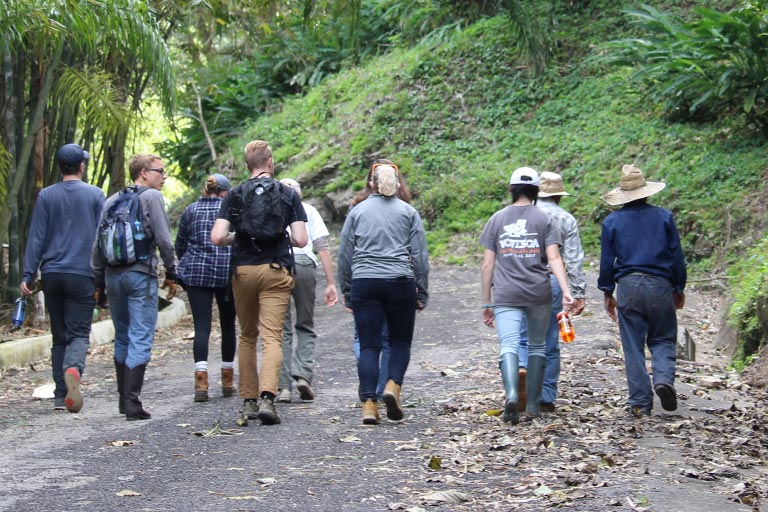Trip Report: Alternative Winter Break in Mexico
The Global Initiatives program embarked upon its annual Alternative Winter Break from December 14 – 21, 2018. The trip was to the Estados Unidos Mexicanos, or the United Mexican States, which is the official name for what we know as simply, Mexico. Taking part in the trip were computer science major Owen Barbour, biomedical engineering major Kate Stiles, aerospace engineering majors Connor Barnhill and Gillian McGlothin, chemical engineering majors Kelsey Hay and Samantha Cahill, civil engineering major Jonathan West, and mechanical engineering major Tyler Wilcox. TCE International Coordinator Judith Mallory led the trip, the 22nd for the Global Initiatives program and its second time in Mexico.
» Read Owen Barbour’s blog.
» Read Connor Barnhill’s blog.
» Read Samantha Cahill’s blog.
» Read Kelsey Hay’s blog.
» Read Gillian McGlothin’s blog.
» Read Kate Stiles’ blog.
» Read Jonathan West’s blog.
» Read Tyler Wilcox’s blog.
Mexico is the fifth largest country in the Americas by total area and the 13th largest independent state in the world. The country is a federation composed of 31 states and Mexico City. According to Wikipedia, Pre-Columbian Mexico dates to about 8000 BC and is identified as one of five cradles of civilization, home to many advanced Mesoamerican civilizations such as the Olmec, Toltec, Teotihuacan, Zapotec, Maya, and Aztec before first contact with Europeans. In 1521, the Spanish Empire conquered and colonized the territory. Three centuries later, the territory became a nation state following its recognition in 1821 after the colony’s Mexican War of Independence. Due to its rich culture and history, Mexico ranks first in the Americas and seventh in the world for number of UNESCO World Heritage Sites.
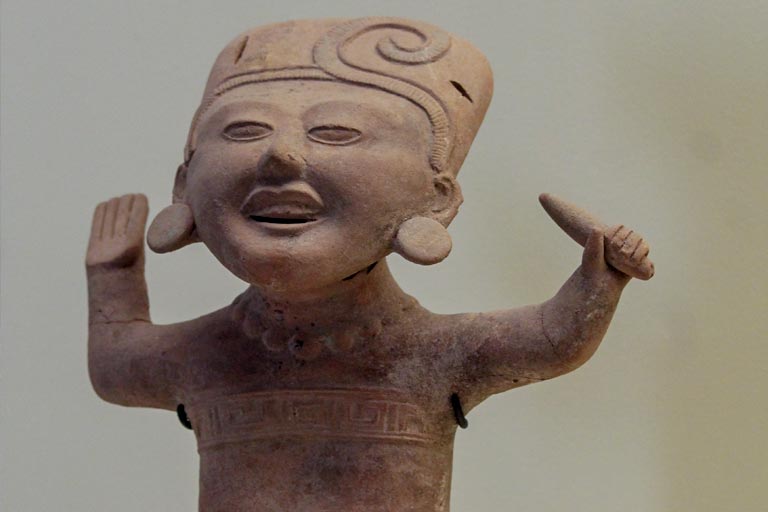
Mexico is an ecologically megadiverse country, ranking fourth in the world for its biodiversity. The country receives a huge number of tourists every year; in 2018, it was the sixth most-visited country in the world, with 39 million international arrivals.
The TCE travelers convened in Ciudad de Mexico, or, Mexico City, a special federal entity (as opposed to a state), the country’s capital and most populous city of the Western Hemisphere and largest Spanish-speaking city in the world. The population of Greater Mexico City is 21.3 million. Mexico City is one of the most important cultural and financial centers in the Americas, and is located in the Valle de México, or, Valley of Mexico, a large valley in the high plateaus in the center of the country, at an altitude of 7,350’ above sea level. Mexico’s capital is both the oldest capital city in the Americas, as well as one of only two founded by Native Americans (the other being Quito, Ecuador.)
Once settled into their lodgings for that night, the group had a brief evening tour of the city center, starting with the Plaza de la Constitución, or, the Zócalo, as it is more commonly known. This large public square and its surrounding area have played a central role in the city’s planning and geography for almost 700 years. The site is just one block southwest of the site of the Templo Mayor which, according to Aztec mythology, was considered the center of the universe. The middle of the square features a flagpole with an enormous Mexican flag which is ceremoniously raised and lowered each day. Lots of activity was taking place on the square, festively decorated with lights for the upcoming Christmas holiday.
The most prominent building on the Zócalo is the Catedral Metropolitana de la Asunción de la Santísima Virgen María a los cielos, or, the Metropolitan Cathedral of the Assumption of the Most Blessed Virgin Mary into Heavens, constructed in sections from 1573 to 1813 and of the Renaissance, Baroque and Neo-classic architectural styles. Next on the tour was the Palacio de Bellas Artes, or Palace of Fine Arts, a major cultural center in the city, which features events in music, dance, theatre, opera, and literature. It is a domed Carrara marble structure primarily of the Art Nouveau and Art Deco styles whose construction began in 1904.
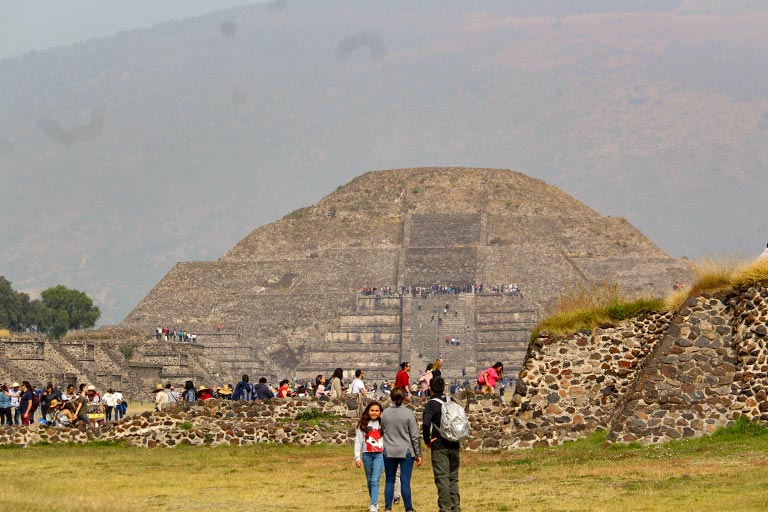
The next day’s agenda consisted of traveling to the nearby archaeological site of Teotihuacán, an ancient Mesoamerican city characterized by pyramids and thought to have been established around 100 BCE. The early history of Teotihuacan is quite mysterious and the origin of its founders is uncertain.
Scholars have suggested that Teotihuacán was a multi-ethnic state, as the ethnicity of its inhabitants is the subject of debate. The site covers 32 square miles and has been designated a UNESCO World Heritage site. It is the most visited archaeological site of the 150+ that are open to the public in Mexico. Its name is believed to mean “place of those who have the road of the gods,” and the Aztecs believe that the gods created the universe there. The site’s broad central promenade, called “Avenue of the Dead,” is flanked by impressive ceremonial architecture, including the immense Pyramid of the Sun, the third largest pyramid in the world. Other structures along the Avenue include the Pyramid of the Moon, The Ciudadela with Temple of the Feathered Serpent Quetzalcoatl, and the Palace-museum Quetzalpapálot. Also along the Avenue are many smaller talud-tablero platforms, common in pre-Columbian archaeological sites. The Aztecs mistakenly believed these were tombs, inspiring the name of the avenue. Scholars have now established that these were originally ceremonial platforms that were topped with temples.
The layout of Teotihuacan exhibits two slightly different orientations, which resulted from astronomical criteria; the two constructions recorded sunrises and sunsets on particular dates, allowing the use of an observational calendar. Both orientations belong to alignment groups that are widespread in Mesoamerica and can be explained with the use of astronomical references at the horizon, allowing organization of a calendar for agricultural purposes, from the sunrises and sunsets of solstices, proving that the placement of the structures did not rely heavily on topographic criteria, but rather on astronomical alignments. Interestingly, there is evidence that the inhabitants modified the route of the San Juan River, as its placement was modified to bend around the structures as it goes through the center of town eventually to return to its natural course outside of Teotihuacan. Unfortunately, the site faces threats from development, including the construction of a nearby Wal-Mart and the installation of a massive light and sound spectacular which has caused fractures in stones and irreversible damage.
From Teotihuacan, the group traveled an hour to the public bus station for the next leg of the trip in a southeasterly direction to the city of Puebla in the neighboring state of the same name. Mexico’s fourth-largest city, Puebla, formally known as Puebla de los Ángeles is known for its stunning architecture, colorful Talavera tiles and mole pablano, Mexico’s national dish, which originated there. Traditional mole is a rich dark sauce made of chilies, spices, nuts, and a little bitter chocolate.
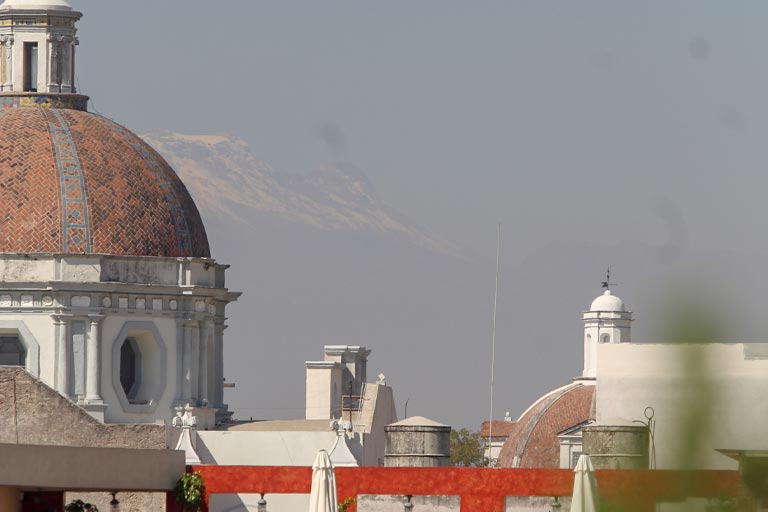
Modern Puebla is a state capital and university city that has preserved its heritage of Colonial architecture. The city sits at 7,005’ above sea level and was founded in 1531, being the first settlement in Mexico to be laid out in a grid pattern. Its cathedral, Catedral de Puebla was consecrated in 1649 as the original national cathedral; it is the second largest in Mexico, constructed in the Renaissance and Baroque styles. At 69 meters high, its steeple and bell tower is the tallest in Mexico. The Cathedral’s stark stone exterior stands in sharp contrast to its resplendent interior features.
Also in Puebla, the group got to visit the impressive Museo Amparo, which houses one of the finest collections of pre-Columbian and Colonial art in the country. One of its prominent features is a pictorial timeline comparing Mesoamerican cultures with contemporary cultures from around the world. Atop the museum is a beautiful roof garden and bar/restaurant, offering commanding views of the city. The main square of Puebla, known as the Plaza Principal, or, Zócalo, although quite a bit smaller than the one in Mexico City, is still remarkable. When the group was visiting, the Plaza was hosting a large antique and flea market.
They also visited a nearby handcrafts market, featuring indigenous goods and food items, including a variety of roasted insects. In between the two markets is a small shop offering tastings of raisin liqueur. Each tiny glass contains a small piece of goat cheese. The group had lunch at the quaint La Fonda Restaurante, a typical Mexican eatery. One wall of the restaurant featured crosses and various images of La Virgen de Guadalupe, the Mexican incarnation of the Virgin Mary. The adjacent wall featured images of notorious bandit-turned-revolutionary, Pancho Villa, including a photo snapped immediately following his assassination.
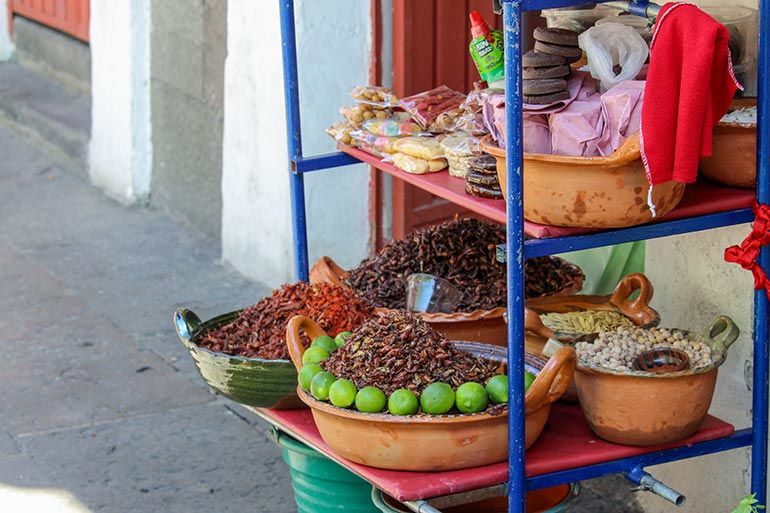
From Puebla, the group continued traveling south to the traditional, indigenous mountain village of Cuetzalan. Situated in the mountains in the south-central state of Puebla in the Sierra Norte region, Cuetzalan has been named “Pueblo Mágico,” a magic city, by the Mexican government. It is formally known as Cuetzalan del Progreso, and is situated at 3130’ in elevation. The main square, the Parroquia de San Francisco de Asis, or Church of St. Francis of Assisi, built in the 17th century, features a Renaissance-style bell tower.
Nearby is another notable and historic church, Santuario de Guadalupe, also known as the Church of the Jarritos, a neo-gothic structure inspired by the Basilica of the Immaculate Conception, in Lourdes, France. Displaying a distinct spire, it is decorated with small terracotta jugs. Surrounding the structure is a cemetery of many above-ground tombs and mausoleum-type structures, all decorated with flowers, candles, ribbons, and small religious articles.
Along with its distinctive architecture and cobblestone streets, Cuetzalan is known for its handicrafts. Garments made on backstrap looms, such as blankets, serapes, ponchos, and rebozo shawls were available at the market, in addition to handmade jewelry. Also available were woodworked items including furniture, crosses, drums, teponaxtles (ancient percussion instruments resembling logs which are played with mallets), rattles and masks. Cuetzalan also produces some of the most aromatic and acclaimed coffee beans in the country. In addition to shopping at the handcrafts market, the group got to visit one of the main attractions of the town, La Cascada de las Brisas, one of the area’s 15 waterfalls, located within the jungle surrounding the town.
They also walked the grounds of the Yohualichan archeological zone, once the home of Otomí and Totonaca groups; its name means “place of the night” and was founded around 600 AD. Its buildings are characteristic features of Tajin culture, and include five pyramidal structures. Finally, the group stopped by Mr. Eugenio Mendez’s Wax Workshop. Eight individuals worked at tables constructing elaborate and intricate wax wreaths and flowers for use in upcoming holiday church services. Food commonly served in Cuetzalan includes elote, grilled corn on a stick, authentic Mexican hamburgers, tacos fritos, and grilled chicken with green pipian sauce, which is made from pumpkin seeds.
Another hour south of Cuetzalan was the destination of the service project, in the tiny village of Taltokalis. The work took place at the La Esperanza del Mañana, or Hope for Tomorrow, ranch. The ranch is the location of a school promoting family entrepreneurship, community partnership, agroforestry, and economic development. The ranch features greenhouses, multiple fruit-bearing trees, and a herd of sheep.
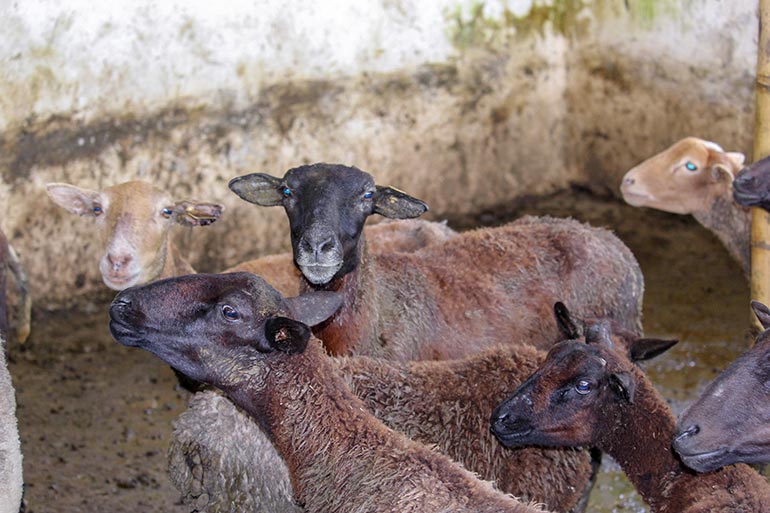
Part of the ranch is home to a sizeable bamboo plantation, funded through concessions from Volkswagen de México, who provided this in exchange for setting up an automobile plant in the state of Puebla, the company’s largest outside of Germany. Since bamboo grows to heights of as much as 22 meters per year, it is perfect for binding large amounts of CO2. In addition, it can be used in building projects.
The students visited the plantation as well as a bamboo home constructed by an architectural student as a thesis project. The house shows that bamboo can be used for what would be considered an upscale dwelling, and that bamboo is not just a building material for poor people to use.
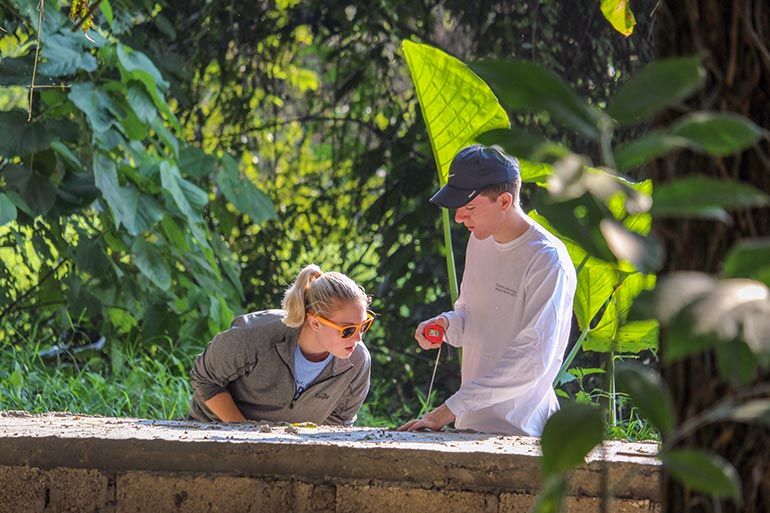
At the ranch, the students performed the service project. Specifically, the group was tasked with constructing an eco-friendly latrina, or outhouse facility. The concrete base was in place, under which containers would be located to collect the waste and after a time, turn it into compost which could eventually be used for fertilizer of non-edible plants. Wood shavings will be used in the facility for sanitation and to help accelerate the composting process. Having this facility keeps the ground water and nearby river from contamination, and provides a private restroom for those attending the programs at the ranch.
The TCE students harvested bamboo with handsaws and machetes, and gathered massive palm fronds from the forest for use in the palapa-style roof. The bamboo was cut into poles for the upright members of the structure, and split lengthwise with a machete for the paneling walls that would form the building. A tamping bar was driven into the ground to serve as a splitter for the palm fronds, which were then braided into thatch that forms the roof and repels water. The student visitors, alongside the native workers, were able to complete the enclosure during their three days of work. After two nights at the ranch, the group began the two-day journey northwards to Mexico City to catch return flights to the United States.
